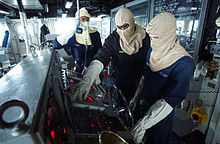Anti-flash gear
Anti-flash gear, also known simply as flash gear, is basic personal protective equipment consisting of a fire-resistant hood and fire-resistant gloves, often made of Nomex.

The purpose of anti-flash gear is to provide protection to the head, neck, face and hands from short-duration flame exposure and heat. This equipment is donned by all shipboard personnel whenever a fire breaks out or during periods of heightened readiness.[1]
Anti-flash gear may be accompanied by other protective gear, such as life belts, helmets, gas masks, etc. While it may be worn by first-response fire-fighting parties, regular shipboard fire-fighters will usually wear full protective gear similar to civilian fire fighters.
History
Anti-flash gear was introduced in the Royal Navy following the Battle of Jutland,[2] when a number of British warships had been destroyed or damaged by flash from burning cordite propellant passing through the shell handling room into the magazine. It was found that the anti-flash hoods and gloves were more effective if flame-proofed with borax or boric acid.[3]
References
- ↑ NAVEDTRA 14057, Damage Controlman. Naval Education and Training Professional Development and Training Center. 2001-04-01.
- ↑ Hough, Richard (1983), The Great War at Sea, 1914-1918, Oxford University Press, ISBN 9780192158710 (p. 223)
- ↑ Australia in the war of 1939-1945 : Ser. 5. Medical, Volume 4 Australian War Memorial, 1961 (p. 122)
| Wikimedia Commons has media related to Anti-flash gear. |